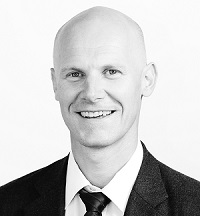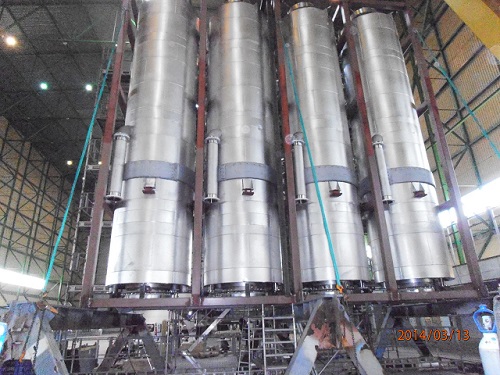Scrubber Deliveries on the Rise Despite Deadline
Wärtsilä is delivering several scrubbers a month in the lead up to the ECA regulations entering into force in Europe in 2015. It is now too late to start and finish an installation project by the end of the year, but this delivery rate is more likely to pick up than to abate.
 “The main argument for scrubbers is that you get a cost saving compared to switching to gas oil inside ECAs, and we initially thought that the financial argument would be the only driver,” says Sigurd Jenssen, director, EGC at Wärtsilä Environmental Solutions. Jenssen had underestimated the importance some shipowners place on their environmental reputation. Wilhelmsen, for example, is installing scrubbers on ROROs that work worldwide and therefore spend little or no time in ECA waters. The company has committed to sail with either reduced sulphur fuel or to use abatement technology as part of a wider environmental commitment.
“The main argument for scrubbers is that you get a cost saving compared to switching to gas oil inside ECAs, and we initially thought that the financial argument would be the only driver,” says Sigurd Jenssen, director, EGC at Wärtsilä Environmental Solutions. Jenssen had underestimated the importance some shipowners place on their environmental reputation. Wilhelmsen, for example, is installing scrubbers on ROROs that work worldwide and therefore spend little or no time in ECA waters. The company has committed to sail with either reduced sulphur fuel or to use abatement technology as part of a wider environmental commitment.
Wärtsilä’s reference list also includes companies such as Neste Shipping, Containership, APL, Color Line, Finnlines and Algoma. The cruise and passenger vessel market has been an obvious candidate for scrubbers due to the high power needs, and therefore high fuel costs, of the vessels, but Jenssen has seen interest in other sectors including LPG carriers and container feeders.
Orders have been split roughly 50/50 between newbuildings and retrofits. Jenssen sees the pace of enquiries increasing, particularly for retrofits, as both operators and charterers start to realise just how expensive marine gas oil is going to be. Compared to LNG or dual-fuel engines, scrubbers are a simple option. “You don’t need to make any changes to the existing infrastructure. It’s pretty much business as usual with the exception that you have an extra piece of equipment at the end of the exhaust stack. There’s not a lot of effort that needs to be put in in terms of maintenance or operational attention, so you can run your ship very much the same what that you always have,” says Jenssen. “You have the same flexibility. No additional crew are needed, and no special training.”
The technical challenges of the technology have been solved. For example, should the installation of a scrubber cause a higher back pressure than that recommended by engine manufacturers, a fan can be installed on the cold side to reduce pressure drop through the system. As the exhaust is saturated with water, it can create a plume in cold areas. The Wärtsilä de-plume system provides hot dry air to eliminate this effect.
Many of the systems sold are hybrid scrubbers that can operate in either open or closed loop mode. When operating in open loop, exhaust gases enter the system and are sprayed with seawater. The sulphur oxides in the exhaust react with the water to form sulphuric acid. Chemicals are not required since the natural alkalinity of seawater neutralizes the acid.
When operating in closed loop, the natural alkalinity of seawater is boosted by an alkaline additive. The hybrid approach enables operation in closed loop mode when required, for instance whilst in port and during maneuvering using NaOH as a buffer. When at sea the switch can be made to open loop using only seawater.
A significant number of orders have been for open loop systems that are made hybrid-ready. “Upgrading is a fairly simple job. It adds some costs, and it isn’t strictly speaking necessary. An open loop system complies with all of the regulations in place today, but it’s a sign that people are thinking a little bit ahead, potentially wanting to operate more in closed loop. It’s a big if, but if there are ports that would implement stricter discharge regulations, you have an advantage with a hybrid system.”
The washwater of both open and closed loop systems is cleaned to the stringent standards currently set by IMO regulations. For now, the main advantage of a closed loop system is that in low alkalinity areas such as the Great Lakes it is more efficient than an open loop system.
The long-term regulatory scene will complicate equipment requirements on board. Wärtsilä’s scrubbers are capable of meeting the 2015 sulfur restrictions and also those expected in 2020, but there is NOx requirements to consider. Jenssen says that the company’s scrubbers have been verified as suitable for partnering with their selective catalytic reduction system for NOx abatement. The scrubbers don’t just clean sulphur, they also remove most soot and particulate matter from a vessel’s exhaust gas, and this may also be regulated in the future.
Financing is a major obstacle for the uptake of scrubbers, particularly when charterers pay for fuel. For a cargo vessel they generally cost between 1 and 2.5 million Euros. For a cruise or passenger vessel, it is difficult to get the costs below 2 million Euros, says Jenssen. Often it is much more. “In these cases you are looking at very large power plants, but then the payback is actually shorter. The cost curve is not linear. The bigger the installation, the lower the cost per megawatt.”
 Wärtsilä offers a range of financing options including using a third party company that uses the fuel savings to pay for the equipment over either a fixed period or at a fixed rate. The manufacturer can handle the whole project on a turn-key basis if desired. This reduces risk and caps costs, says Jenssen.
Wärtsilä offers a range of financing options including using a third party company that uses the fuel savings to pay for the equipment over either a fixed period or at a fixed rate. The manufacturer can handle the whole project on a turn-key basis if desired. This reduces risk and caps costs, says Jenssen.
Coming before the 2015 deadline is the next MEPC meeting. Held this month, scrubbers will be on the agenda, but, says Jenssen, the meeting is just expected to fix up some technicalities. There’s nothing that is likely to influence shipowners’ decision making on the adoption of scrubbers. Typically, the full project can take around nine months to complete, so those still considering their options will have to factor in extra fuel costs in the interim.
